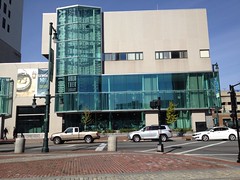 |
| Harold Washington Library Center |
Ranked first, Slovakia has an estimated 5.5 million people and 7,551 total libraries:
There is 1 National Library, 8 scientific libraries, 33 academic libraries, 2,598 public libraries, 357 special libraries and 4,554 school libraries in Slovakia. (link)Meanwhile, the United States has 325 million people (2016) and an estimated 119,487 libraries (2015). While the math says nothing about access or if the person is closest to an appropriate library for the person's request, a library in Slovakia serves 728 people, while one library in the U.S. serves 2,719 people.1 [The iSchool@Online post stated 30.35 libraries per 100,000 residents which equals one library for every 3,295 people. In my mind, not wildly different that using the ALA and U.S. Census data.]
More libraries in the U.S. than McDonald's Restaurants! This is a statistic that gets tossed out because there seem to be many McDonald's. Those modern or traditional golden arches are easy to spot and we often use them as landmarks when giving directions. You'll find a McDonald's in highly trafficked areas, with mini-locations in places like malls and airports.
The U.S, also has more libraries that the number towns and cities recognized by the U.S. Geological Survey (over 35,000).
Where are the libraries? Often they are in the center of their town, village, campus or school. They may not be in high traffic areas and some aren't well served by public transportation. Our libraries generally do not have flashy signage which beckon people towards them. Rarely do you find branches in bus or train stations, or airports. Yes, a few do exist in malls, but that is not the norm. Yes, I recognize that libraries are not evenly distributed.
My thought is that with a library in the U.S. for every 2,719 - 3,295 people, even if they are not in high traffic areas, libraries should stand out in our minds. But do they? And are all of the people in a library's service area using the library? Yes, I've just stated a problem that we all know. For me, the problem is made more real through statistics. And sadder given our need for information literacy training, access to reliable, verifiable information, and safe space for all people.
This has also been made more real for me because in December, I joined the Board of Trustees of the Onondaga County Public Library (OCPL). OCPL operates the Central Library and ten city libraries, and serves 21 independent libraries in suburban Onondaga County. With an estimated 468,500 residents, we have one public library for every 14,640 people. Yes, there are also school, academic, medical, law and other libraries. While counting them makes the ratio better, not every library is open to everyone. In addition, some special topic libraries (e.g., medical) may be difficult for someone to visit. This is a fact not only in Onondaga County, but also in other parts of our world. Not every library is open to everyone. Sadly, there are areas of Onondaga County that are library deserts, meaning that there isn't an available library within a reasonable distance.
 |
| Public library in Portland, ME |
In 2017, we have more people making decisions based on information that they do not understand and do not even know if it is accurate. Libraries of all kinds need to make themselves better known and help people sift through fake news, verify details, and build knowledge. Libraries need to find ways of bridging their deserts, perhaps by creating innovative information pathways. Libraries need to create safe, multi-cultural, multi-lingual spaces. (Our communities are multi-cultural and multi-lingual, so should our libraries be that too?)
The clock is ticking. Let's get started.
The above infographic and data analysis was created by Syracuse University's School of Information Studies master of information management program. Thanks for prompting me to think about this!
1. Divide the population of Slovakia (5,500,000) by the number of libraries (7,551) equals one library for every 728 people. In the U.S. (population of 325,000,000), there are 119,487 public libraries, or one library for every 2,719 people. The iSchool@Online blog post stated 30.35 libraries for every 100,000 people in the U.S., or one library for every 3,295 people.↩

1 comment:
Great call to action, Jill, and at least one of the underlying messages is well worth repeating: blending in rather than standing out is not a great way to serve a community.
Post a Comment